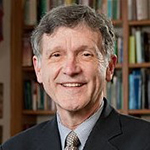By Bill Leonard
 Each January for the last three years I’ve joined a group of students in visiting the Haywood Street Congregation in Asheville, N.C., and each time we’ve gotten a taste of God’s New Community (aka the Kingdom of God) in the world. The Haywood Street Congregation is one of multiple sites visited during a 12-day experiential learning course called “Fierce Landscapes: Listening to the People of Appalachia.” I knew that adding Haywood Street would be meaningful, but I had no clue how transformative it would be for students, faculty, and anyone else who tags along.
Each January for the last three years I’ve joined a group of students in visiting the Haywood Street Congregation in Asheville, N.C., and each time we’ve gotten a taste of God’s New Community (aka the Kingdom of God) in the world. The Haywood Street Congregation is one of multiple sites visited during a 12-day experiential learning course called “Fierce Landscapes: Listening to the People of Appalachia.” I knew that adding Haywood Street would be meaningful, but I had no clue how transformative it would be for students, faculty, and anyone else who tags along.
Offered by the Wake Forest University School of Divinity and funded in part through a grant from the Appalachian Ministries Educational Resource Center (AMERC) in Berea, Ky., the consortium-based course draws students from various theological schools — this year from Wake Forest, Baptist Theological Seminary at Richmond, Va., and Andover Newton Theological School, Newton, Mass. Amid lectures and readings on religion in Appalachia, there are visits with community activists related to mountain churches, community agencies, schools, medical care, prisons, hospice, and other nonprofit programs.
Boarding at High Pastures Retreat Center, up a hollow from Burnsville, N.C., we experience the beauty of the mountains and the vicissitudes of the Appalachian winter. The day we visited Haywood Street the temperature was headed for single digits and below zero wind chill, a situation with significant impact on the homeless population that is the congregation’s primary constituency.
The congregation gathers in a building that once housed the Haywood Street United Methodist Church in downtown Asheville. Its founding pastor, Rev. Brian Combs, originally appointed as a United Methodist missionary to Asheville’s homeless population, is assisted by Rev. Darryl Dayson and hosts of volunteers. Weekday ministries include recovery groups, Bible studies, haircuts, Story Circles, AA meetings, clothes closets, community gardens, acupuncture therapy, and respite-care medical facilities. Wednesdays they serve lunch and convene for worship. The multi-course meal, provided for as many as 400 individuals in three seatings, is served boarding-house style, on real plates with cloth napkins. The day we visited, the place was particularly jam-packed because of harsh weather. Sometimes the church’s greatest gift is a place to come in out of the cold.
At worship, the printed program offered this spiritual disclaimer: “Today’s liturgy may be blown away by the Spirit at any moment.” The Prayers of the People were just that, with participants calling out prayer requests for personal and familial matters, illnesses, international upheavals, ailing dogs and cats, weather protection, and other concerns, each offered up in congregational call and response by shaking plastic bottles filled with pebbles — a sound surely as sweet in God’s hearing as it is collectively engaging for the worshiping community.
The “Conversational Homily” was equally responsive, especially when the preacher asked for commentary on the day’s text, the baptism of Jesus by John the Baptizer (Mark 1:4-11). Congregants responded readily:
• The text is about the Trinity, one person insisted, since Father, Son, and Spirit were all acknowledged at the baptism.
• John was the first to recognize Jesus, another noted, kicking in his mama’s belly before either of them was born.
• Jesus needed John to prepare the way, said another — the two working together for our redemption.
• John and Jesus were both outsiders, one person observed, neither was what the world expected.
• Another asked the preacher if they might add locusts (John’s diet) to the Wednesday menu!
At Holy Communion we all came forward — street people, volunteers, seminarians — sacramental signs of great racial, economic, physical, and generational community. Some folks even carried or led their dogs, also bundled up against the urban cold. Dog food, too, is freely offered at Haywood Street.
The final hymn, a recording of Elton John’s Tiny Dancer, got us all singing, as two women danced spontaneously down the aisle, and the preacher affirmed that “there’s a tiny dancer in all of us.”
Jesus says: “When you are having guests for lunch or supper, do not invite your friends, your brothers or other relations, or your rich neighbors; they will only ask you back again and so you will be repaid. But when you give a party, ask the poor, the crippled, the lame and the blind. That is the way to find happiness because they have no means of repaying you” (Luke 14:12-14, REB).
Haywood Street’s worship program says: “A witness to include the most excluded, Haywood Street not only welcomes every child of God — especially sisters and brothers of every mental illness and physical disability, addiction and diagnosis, living condition and employment status, gender identity and sexual orientation, class, color and creed — but we celebrate your presence, certain that the kingdom of God is coming closer because you are here.”
John Dominic Crossan says that for Jesus, the kingdom of God means healing those who are hurting, and eating with those who have been healed; and out of the healing and eating together comes God’s New Community. Haywood Street’s “witness” proves that whatever else God’s New Community may mean provisionally, if it ultimately fails “to include the most excluded,” then it really isn’t Community, and it certainly isn’t God’s.
